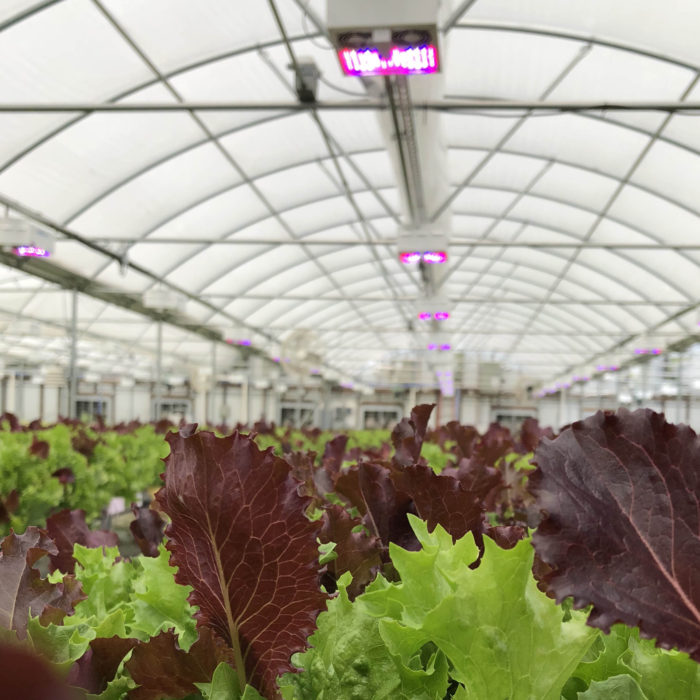Photo – Lumigrow Lights at Lettuce Work Foundation www.lumigrow.com
Electricity is needed for indoor growsUsing standard lighting equipment for indoor agriculture requires 20-50 times the lighting intensity per square foot as human occupancy lights. Electric bills can dominate operating costs, in addition to bulb replacements and air conditioning to remove excess heat. Growers face a well-known lighting choice: an inexpensive HPS energy-hog or spending 3-5 times upfront for an efficient alternative. With the free lighting source, otherwise known as “the sun”, many wonder, “why dabble in indoor food production at all?”
The perks of indoor farming
Although I’m not a grower, I understand the reasons for growing food indoors include environmental control, resource productivity and proximity to market. Inside a controlled environment (which includes most greenhouses), plants are given ideal conditions for temperature, light, humidity and nutrients – a sunny, summer day 365 days of the year. This increases productivity per unit of input and can accelerate cycle time. Some farms report that an indoor facility, with vertical rows, can produce up to 130 times more yield per square foot each year than growing outside. Increasing population combined with limited farmland and water makes indoor agriculture seem like a good option to explore. Growing in a controlled environment can also satisfy consumer demand for year-round locally-grown food. However, the main drawbacks to growing food indoors are upfront capital costs (for the facility and equipment) and energy use.
Rebates minimize drawbacks
Utility rebates and efficient equipment can help reduce upfront and ongoing electric costs by 40-60%. Cash rebates can be tens of thousands of dollars or greater – real money. I have processed rebates for a microgreens farm in MA, a veggie farm in AL, and a nursery in NY. I’ve also consulted on a dozen inquiries from churches, community groups and businesses looking to grow food. Rebates are real and utilities are going out of their way to influence purchase decisions. But they are easy to mess up or misunderstand.
Disguised, yet available rebates
There are a few common mishaps that reduce rebates or disqualify grows from receiving them. For example, you won’t find “indoor agriculture” rebates, and pursuing “lighting programs” will lead to misinformation. Using lights to grow food should be considered a “custom rebate” or “industrial process”. They should not be subjected to energy codes or qualifying conditions that pertain to human-vision lighting. In addition, rebates depend heavily on identifying baseline conditions (energy and cost) for new construction projects, and published research in this area is lacking.
Savings calculations & project size
There are over 3,000 electric utilities in the United States and each has unique rebate offerings with different cost caps, incremental costs, and savings reimbursement rates. The inputs and math for calculating energy consumption or savings incorporates hours of use, fixture counts, lighting intensity, interaction with other systems, instillation labor, and permitting costs. Because custom utility applications require extensive time and attention from utility staff, they are mostly available for larger commercial projects only. I generally advise that projects should be above $30k in lighting expenses to merit a custom application. They are not as simple as a mail-in lightbulb rebate.
Process is important
Remember to engage with your utility before purchasing any lights! When you do, have a plan for your facility incorporating the lights you would like to purchase, ideally with a sales quote. If you’re using timer or controls (including photo sensors) get as much information about the expected hours of use. For more information, I have covered basics of cannabis rebates, which apply to other crops at https://seinergy.com/grow-lamp-rebates-101-a-beginners-guide/
Don’t forget your veggies!
I spend a lot of time discussing utility rebates and lighting choices for indoor cannabis growers. The cannabis industry has demanded energy-use attention because of the large quantity of new businesses opening and lights being purchased. However, I cannot ignore the increase of indoor agriculture as food production and the many ways experience with cannabis energy overlaps into other crops. There is also a huge opportunity for indoor food growers to receive significant rebates from efficient equipment choices, reducing energy use and saving money for years.




